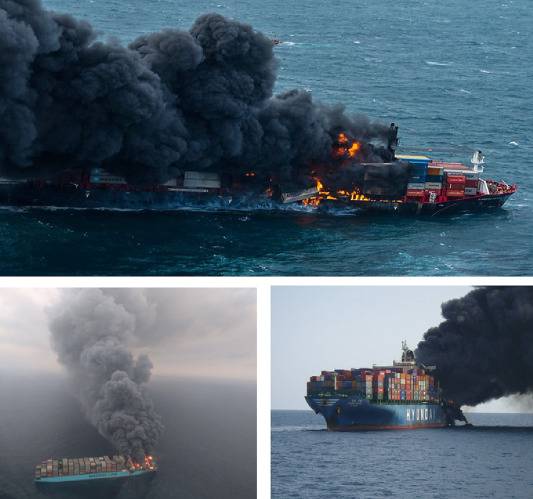Anna Huff | March 31, 2023

New research from an international team of scientists—including Mona Wells, director of climate science at The Meadows Center for Water and the Environment at Texas State University—finds significant flaws in the environmental management of the container ship industry and recommends new methods to streamline environmental impact assessments of container ship disasters.
Their research was published in two papers in the journal Marine Pollution Bulletin, centering around the May 2021 X-Press Pearl container ship disaster. Considered one of the worst marine ecological shipping disasters and the world’s worst spill of nurdles (plastic pellets used in manufacturing), the X-Press Pearl container ship caught on fire and burned for 12 days before sinking in the coastal waters of Sri Lanka in May 2021. In addition to the ship wreckage, scientists mapped 180 locations where lost containers and other debris had fallen overboard during the fire.

“The X-Press Pearl disaster was a tragedy, and the probability of such events recurring is likely to increase under the pressures of globalization and economic development,” Wells said. “A disaster of this magnitude presents an opportunity to promote more effective environmental management of container ship operations and should serve as a wake-up call for global shipping.”
The first paper, “The X-Press Pearl disaster underscores gross neglect in the environmental management of shipping: Review of future data needs,” investigates the unique aspects of the container ship industry that contribute to environmental disasters. It also discusses gaps that hinder adequate environmental impact assessments of maritime shipping disasters.
While the container ship industry has been around since the 1940s, the Shipping Act of 1984 brought exponential growth that also led to an increase in ship size and container capacity. Today, roughly 830 million containers are processed at ports across the globe each year, and as much as 40% of those carry hazardous materials.
The paper points to several factors contributing to on-ship disasters and direct container loss. One issue arises from the “flag of convenience,” which allows ship owners to register their ships in another country to avoid stricter environmental and safety standards. In 2021, nearly two-thirds of the world’s fleet was registered in countries with no connection to the registered ships.
Other issues include ship owners failing to declare or falsifying information about dangerous cargo onboard to save time and costs. Roughly 45% of major fires on container ships resulted from undeclared goods.
Lost containers are another major contributor to environmental damage. According to the paper, current data on container contents and loss are grossly lacking, making it impossible to undertake any quantifiable assessments of environmental risks. Very little research exists on the adverse impacts shipping traffic has to coastal ecosystems, leaving substantial gaps in terms of the effects of environmental impact and pollution.
Recent projections show container ship traffic will continue to increase in the coming decades, which the paper argues will only increase the frequency and magnitude of disasters like the X-Press Pearl. The authors conclude that one of the best ways to manage impacts of container ship operations is by proactively reducing its scale. Aside from scale, with the lack of reliable data, more impact studies are needed to inform future understanding of risks and the best approach to environmental management interventions for events such as the X-Press Pearl.
The second paper, “We need to plan streamlined environmental impact assessment for the future X-Press Pearl disasters,” reviews studies demonstrating a lack of fit-for-purpose environmental impact assessment (EIA) of the X-Press Pearl disaster and proposes using whole-cell bioreporter technology to streamline EIA for maritime disasters. Post-disaster EIAs are used to identify environmental issues resulting from disasters and inform decision-makers in disaster response strategies.
“The evaluation of the environmental issues arising from the X-Press Pearl disaster, and the resulting impact, should not be relegated to simple text that exists in a report. Rather, practical, agile and effective streamlined EIA is required,” Wells said. “Whole-cell bioreporters offer an ideal solution to many challenges in short-term assessment.”
The authors argue that traditional methods for conducting an EIA are time-consuming, inefficient, require a high level of organization and can leave the affected country tasked with creating an assessment from scratch in the wake of disaster. Furthermore, measuring the concentration of pollutants released into the environment from a disaster is not enough to assess the potential damage. A link must be established between the release of the pollutants and subsequent biological effects in order to accurately assess the environmental damage.
Whole-cell bioreporter technology provides a much-needed solution to this issue by rapidly detecting the bioavailability, stressor effects and toxicity of environmental pollutants. Bioreporters are genetically modified single-cell organisms that are engineered to give a “report” on harmful compounds and priority environmental contaminants.
The authors suggest that whole-cell bioreporter technology can streamline impact assessments for maritime disasters and advance efficient, timely decision-making when disasters occur. However, future work is needed to ensure that bioreporter technology realizes its full potential in the EIA of environmental contaminants released during disasters such as the X-Press Pearl.
“Using bioreporters represents an extremely fit-for-purpose approach that can be deployed after a maritime disaster in the short term while long-term plans are made and implemented,” Wells said. “We hope this research will be illustrative in advancing efficient and rapid EIA in response to such maritime disasters.”
The research was an outgrowth of prior advisory work funded by the United Nations.
About The Meadows Center for Water and the Environment
The Meadows Center for Water and the Environment at Texas State University was named following a generous gift from The Meadows Foundation in August 2012. The Meadows Center inspires research, innovation and leadership that ensures clean, abundant water for the environment and all humanity.
Share this article
For more information, contact University Communications:Jayme Blaschke, 512-245-2555 Sandy Pantlik, 512-245-2922 |
